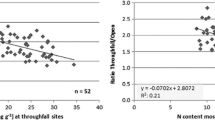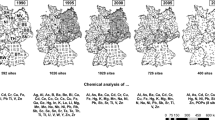Abstract
In this study, the canopy drip effect on the exposure of forests to atmospheric deposition of potentially toxic metals and nitrogen (N) and element accumulation was investigated. Thereby, the respective element concentrations of metals and N in moss specimens were investigated by example of North-Western Germany. To this end, on the one hand, the concentrations of Al, As, Cd, Cr, Cu, Fe, Hg, Pb, Ni, Sb, V, Zn, and N in mosses sampled under, outside, and at the edge of forest canopies were examined for statistical significant differences. On the other hand, vegetation structures parameterizing the canopy drip effect were quantified by use of information collected, in addition to the element data, at each moss sampling site. The statistical relations between ratios of vegetation parameters and ratios of element concentrations were modeled by regression analysis, and the respective element concentration in moss was geostatistically estimated and mapped for unsampled locations throughout Germany. This article tackles regression models with R2 > 0.5 (Cu, Hg, Pb, Sb, and N) to adapt the element concentrations measured at the 400 sites of the European Moss Survey (EMS) to three different features of hypothetical vegetation structures. To this end, the continuum of vegetation structures were represented as follows: open land (meadows) described by a leaf area index (LAI) value of 2.96 and under canopy sites in coniferous forests represented by a LAI value of 11. The arithmetic mean of LAI values at 400 EMS sites throughout Germany amounts to 5.1. The element concentrations for these target LAIs representing three site categories were calculated and mapped. Then, these LAI-dependent element concentration maps were compared with the maps depicting the spatial patterns of “pure” element concentrations. Spatial differences were evaluated and supposed to be of great value for the validation of atmospheric deposition modeling.






Similar content being viewed by others
References
Arndt U, Nobel W, Schweizer B (1987) Bioindikatoren. Möglichkeiten, Grenzen und neue Erkenntnisse. Stuttgart, Ulmer
Beudert B, Breit W (2012) Horizontaler Niederschlag, nasse und feuchte Deposition im Inneren Bayerischen Wald - erste Ergebnisse. Bericht im Auftrag des Umweltbundesamtes. FKZ 351 012(/04):01
BMEL (2013) Waldzustandsbericht 2013. Bundesministerium für Ernährung und Landwirtschaft (BMEL), Berlin
BMVEL (2006) Arbeitsanleitung für die zweite Bodenzustandserhebung im Wald (BZE II), Kapitel IX Aufnahme der Waldbodenvegetation 2. Auflage. Bundesministerium für Verbraucherschutz, Ernährung und Landwirtschaft (BMVEL), Berlin
Bremicker M (2000) Das Wasserhaushaltsmodell LARSIM - Modellgrundlagen und Anwendungsbeispiele. Freiburger Schriften zur Hydrologie, Band 11. Institut für Hydrologie der Universität Freiburg, Freiburg
Brosius F (2013) SPSS 21. Mitp/bhv, Heidelberg
Builtjes P, Hendriks E, Koenen M, Schaap M, Banzhaf S, Kerschbaumer A, Gauger T, Nagel H-D, Scheuschner T, Schlutow A (2011) Erfassung, Prognose und Bewertung von Stoffeinträgen und ihren Wirkungen in Deutschland. MAPESI-Projekt (Modelling of Air Pollutants and EcoSystem Impact). UBA-Texte 42/2011. Abschlussbericht, Stuttgart
De Schrijver A, Staelens J, Wuyts K, Van Hoydonck G, Janssen N, Mertens J, Gielis L, Geudens G, Augusto L, Verheyen K (2008) Effect of vegetation type on throughfall deposition and seepage flux. Environ Pollut 153:295–303
Dreyhaupt EJ (1979) Handbuch zur Aufstellung von Luftreinhalteplänen. Verlag TÜV Rheinland, Köln
EAE (European Environment Agency) (2016) Corine Land Cover 2012 raster data. https://www.eea.europa.eu/data-and-maps/data/clc-2012-raster. Accessed 13 Dec 2017
Fagerli H, Tsyro S, Denby BR, Nyíri Á, Gauss M, Simpson D, Wind P, Benedictow A, Jonson JE, Klein H, Schulz M, Griesfeller J, Aas W, Hjellbrekke A-G, Solberg S, Platt SM, Fiebig M, Yttri KE, Rud RO, Tørseth K, Mareckova K, Pinterits M, Tista M, Ullrich B, Wankmüller R, Posch M, Bergström R, Imhof H, Minguillón MC, Putaud J-P, Cavalli F, Poulain L, Schlag P, Heikkinen LM, Swietlicki E, JMartinsson J, Vana M, Smejkalova AH, Kouvarakis G, Mihalopoulos N (2017) Transboundary particulate matter, photo-oxidants, acidifying and eutrophying components. The Norwegian Meteorological Institute, Oslo
Frahm JP (1998) Moose als Bioindikatoren. Quelle & Meyer GmbH & Co., Wiesbaden
Fränzle O, Kappen L, Blume H-P, Dierßen K (eds) (2008) Ecosystem organization of a complex landscape: long-term research in the Bornhöveder Lake District, Germany. Ecological studies 202. Springer, Berlin
Gruber JP (2001) Die Moosflora der Stadt Salzburg und ihr Wandel im Zeitraum von 130 Jahren. Stapfia 79:3–155
Hollaus M, Milenković M, Pfeifer N 2014. A review of surface roughness concepts, indices and applications. Interreg alpine space project –NEWFOR, final report. Austria, Vienna. http://www.newfor.net/wp-content/uploads/2015/02/DL15-NEWFOR_Roughness_state_of_the_art.pdf. Accessed 1 June 2018
ICP Vegetation (International Cooperative Programme on Effects of Air Pollution on Natural Vegetation and Crops) (2014) Monitoring of atmospheric deposition of heavy metals, nitrogen and POPs in Europe using bryophytes. Monitoring manual 2015 survey. United Nations economic Commission for Europe Convention on long-range transboundary air pollution. ICP vegetation Moss survey coordination Centre, Dubna, Russian Federation, and Programme coordination Centre. Bangor, Wales, UK
Ilyin I, Rozovskaya O, Travnikov O, Varygina M, Aas W, Pfaffhuber KA (2016) Assessment of heavy metal transboundary pollution, progress in model development and mercury research. EMEP Status Report 2/2016. Meteorological Synthesizing Centre - East, Moscow, Russian Federation
Kluge M, Pesch R, Schröder W, Hoffmann A (2013) Accounting for canopy drip effects of spatiotemporal trends of the concentrations of N in mosses, atmospheric N depositions and critical load exceedances: a case study from North-Western Germany. Environ Sci Eur 25(26):1–13
Lazo P, Steinnes E, Quarri F, Allajbeu S, Kane S, Stafilov T, Frontasyeva MV, Harmens H (2018) Origin and spatial distribution of metals in moss samples in Albania: a hotspot of heavy metal contamination in Europe. Chemosphere 190:337–349
Liu S, Dissanayake S, Patel S, Dang X, Mlsna T, Chen Y, Wilkins D (2014) Learning accurate and interpretable models based on regularized random forests regression. BMC Syst Biol 8:1–9
McElhinny C, Gibbons P, Brack C, Bauhus J (2005) Forest and woodland stand structural complexity: its definition and measurement. For Ecol Manag 218((1–3)):1–24
Merian E, Anke M, Ihnat M, Stoeppler M (2004) Elements and their compounds in the environment: occurrence, analysis and biological relevance, vol 1. Wiley, 1806 pp
Meyer M (2017) Standortspezifisch differenzierte Erfassung atmosphärischer Stickstoff- und Schwermetalleinträge mittels Moosen unter Berücksichtigung des Traufeffektes und ergänzende Untersuchungen zur Beziehung von Stickstoffeinträgen und Begleitvegetation. Diss. Univ. Vechta:1–262 + 86 S. Anh
Meyer M, Schröder W, Hoffmann A (2015a) Effect of canopy drip on accumulation of nitrogen and heavy metals in moss. Pollution Atmosphérique N°226:1–29
Meyer M, Schröder W, Nickel S, Leblond S, Lindroos AJ, Mohr K, Poikolainen J, Santamaria JM, Skudnik M, Thöni L, Beudert B, Dieffenbach-Fries H, Schulte-Bisping H, Zechmeister HG (2015b) Relevance of canopy drip for the accumulation of nitrogen in moss used as biomonitors for atmospheric nitrogen deposition in Europe. Sci Total Environ 538:600–610
Mohr K (1999) Passive Monitoring von Stickstoffeinträgen in Kiefernforsten mit dem Rotstengelmoos (Pleurozium schreberi (Brid.) Mitt.). Umweltwissenschaften und Schadstoff-Forschung 11:267–274
Mohr K (2007) Biomonitoring von Stickstoffimmissionen. Möglichkeiten und Grenzen von Bioin- dikationsverfahren. Umweltwissenschaften und Schadstoff-Forschung 19:255
Nickel S, Schröder W (2017) Umstrukturierung des deutschen Moos-Monitoring-Messnetzes für eine regionalisierte Abschätzung atmosphärischer Deposition in terrestrische Ökosysteme. In: Schröder W, Fränzle O, Müller F (eds) Handbuch der Umweltwissenschaften. Grundlagen und Anwendungen der Ökosystemforschung. Kap. V-1.8. 24. Erg.Lfg. Wiley-VCH, Weinheim, pp 1–47
Nickel S, Schröder W, Fries C (2017) Synoptische Auswertung modellierter atmosphärischer Einträge von Schwermetallen und deren Indikation durch Biomonitore in Wäldern. Gefahrstoffe - Reinhaltung der Luft (SpringerVDI) 3/2017:75–90
Nultsch W (2012) Allgemeine Botanik. 12. Auflage. Thieme, Stuttgart
Peichl L (1997) Empfehlung des Länder-Arbeitskreises “Bioindikation/Wirkungsermittlung” für die landesweite Erhebung von Immissionswirkungen mit Bioindikatoren. Umweltwissenschaften und Schadstoffforschung 9:273–282
Pesch R, Schröder W, Genssler L, Goeritz A, Holy M, Kleppin L, Matter Y (2007) Moos-Monitoring 2005 / 2006: Schwermetalle IV und Gesamtstickstoff. Berlin (Umweltforschungsplan des Bundesministers für Umwelt, Naturschutz und Reaktorsicherheit. FuE-Vorhaben 205 64 200, Abschlussbericht, im Auftrag des Umweltbundesamtes); 90 S., 11 Tabelle, 2 Abbildung (Texteil); 51 S. + 41 Karten, 34 Tabellen, 46 Diagramme (Anhang)
R Core Team (2013) R: a language and environment for statistical computing. R Foundation for Statistical Computing, Vienna
Ross SM (1994) Toxic metals in soil-plant systems. Wiley, New York, p 469
Sachs L, Hedderich J (2009) Angewandte Statistik. Methodensammlung mit R. Springer, Berlin
Schröder W (2006) GIS, geostatistics, metadata banking and tree based models for data analysis and mapping in environmental monitoring and epidemiology. Int J Med Microbiol 296S1:23–36
Schröder W, Holy M, Pesch R, Zechmeister H, Harmens H, Ilyin I (2011a) Mapping atmospheric depositions of cadmium and lead in Germany based on EMEP deposition data and the European Moss Survey 2005. Environ Sci Eur 23(19):1–14
Schröder W, Holy M, Pesch R, Harmens H, Fagerli H (2011b) Mapping background values of atmospheric nitrogen total deposi-tions in Germany based on EMEP deposition modelling and the European Moss Survey 2005. Environ Sci Eur 23(18):1–9
Schröder W, Nickel S, Jenssen M, Riediger J (2015) Methodology to assess and map the potential development of forest ecosystems exposed to climate change and atmospheric nitrogen deposition: a pilot study in Germany. Sci Total Environ 521-522:108–122
Schröder W, Nickel S, Völksen B, Dreyer A (2017) Nutzung von Bioindikationsmethoden zur Bestimmung und Regionalisierung von Schadstoffeinträgen für eine Abschätzung des atmosphärischen Beitrags zu aktuellen Belastungen von Ökosystemen. 4. Zwischenbericht, F&E-Vorhaben UFOPLAN 3715 63 212 0, im Auftrag des Umweltbundesamtes, Dessau. Text 82 S. + 4 Anhänge 212 S
Schröder W, Nickel S, Schaap M, Hendriks C, Jonkers S, Builtjes P, Schlutow A, Nagel H-D, Scheuschner T (2018) Impacts of heavy metal emission on air quality and ecosystems across Germany. Sources, transport, deposition and potential hazards. Final report. UFOPLAN no. 3713 63 253. Dessau, Straußberg, Utrecht, Vechta. 386 pp. including attachments
Skudnik M, Jeran Z, Batič F, Simončič P, Lojen S, Kastelec D (2014) Influence of canopy drip on the indicative N, S and δ15 content in moss Hypnum cupressiforme. Environ Pollut 190:27–35
Skudnik M, Jeran Z, Batič F, Simončič P, Kastelec D (2015) Potential environmental factors that influence the nitrogen concentration and values in the moss Hypnum cupressiforme collected inside and outside canopy drip lines. Environ Pollut 198:78–85
Steinnes E (1995) A critical evaluation of the use of naturally growing moss to monitor the deposition of atmospheric metals. Sci Total Environ 160/161:243–249
UBA (2011) Stickstoff - Zuviel des Guten? Broschüre des Umweltbundesamtes, Dessau-Roßlau, 42 S
UCLA (2011) FAQ: what Are Pseudo R-squareds? UCLA - Statistical Consulting Group. https://stats.idre.ucla.edu/other/mult-pkg/faq/general/faq-what-are-pseudo-r-squareds/. Accessed 1 June 2018
Ulrich B, Mayer R, Khanna K P (1979) Deposition von Luftverunreinigungen und ihre Auswirkungen in Waldökosystemen im Solling. Schriften aus der Forstlichen Fakultät der Universität Göttingen und der Niedersächsischen Forstlichen Versuchsanstalt, Universität Göttingen 58. Sauerländer
Weligepolageab K, Gieskea ASM, Sua Z (2012) Surface roughness analysis of a conifer forest canopy with airborne and terrestrial laser scanning techniques. Int J Appl Earth Obs Geoinf 14(1):192–203
Zöttl HW (1985) Heavy metal levels and cycling in forest ecosystems. Experientia 41:1104–1113
Acknowledgments
This research paper was only possible through the help and support of the German Environment Agency (Umweltbundesamt, Dessau-Roßlau, Germany).
Author information
Authors and Affiliations
Corresponding author
Additional information
Responsible editor: Philippe Garrigues
Electronic supplementary material
ESM 1
(PDF 1683 kb)
Rights and permissions
About this article
Cite this article
Schröder, W., Nickel, S. Site-specific investigation and spatial modeling of canopy drip effect on element concentrations in moss. Environ Sci Pollut Res 25, 27173–27186 (2018). https://doi.org/10.1007/s11356-018-2763-y
Received:
Accepted:
Published:
Issue Date:
DOI: https://doi.org/10.1007/s11356-018-2763-y




